How To Get Rid Of Cradle Cap In Toddlers & Tips To Prevent It
Cleanse your child's scalp off yellow flakes with a few simple natural solutions.
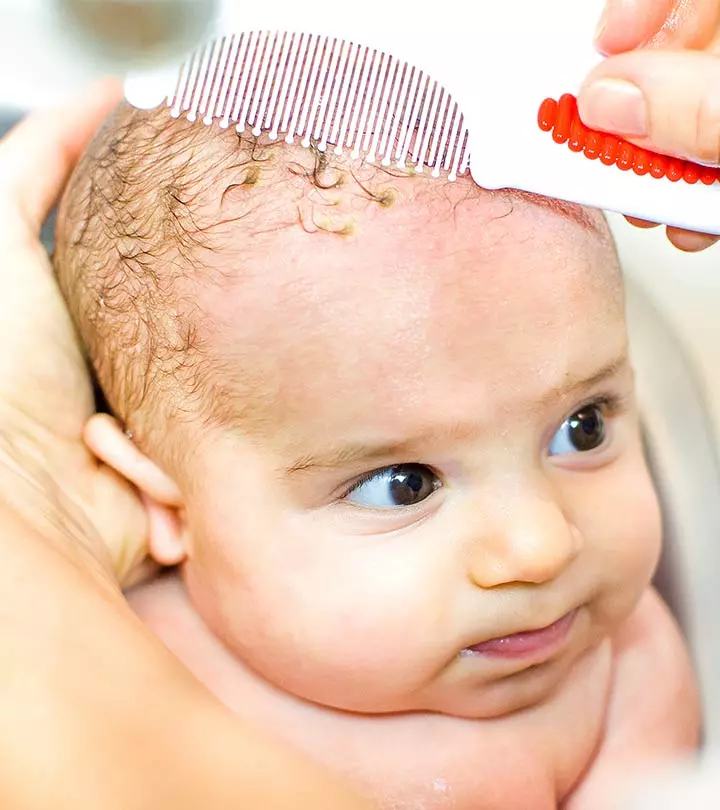
Image: Shutterstock
Cradle cap is a skin condition commonly seen in infants. If you see flaky, thick, and yellow patches on your baby’s scalp, chances are your little one has a cradle cap. The good news is that the cradle cap is harmless and goes away by itself. If you don’t want to wait for it to clear up on its own, there are a few quick remedies you can try to get rid of cradle caps in toddlers. In this article, we get a deeper understanding of cradle cap and some simple natural remedies you can use at home.
In This Article
What Is Cradle Cap?
A cradle cap is a medical condition that causes crusty or oily and scaly patches on a baby’s scalp
. It is medically known as infantile seborrheic dermatitis. Although it is not itchy, it can cause thick white or yellow scales that are difficult to get rid of.
While cradle cap is a common and generally harmless condition, it can sometimes be mistaken for other skin conditions like eczema or psoriasis, especially in severe cases. These conditions may require different treatment approaches, so it is important to consult a healthcare professional for accurate diagnosis and appropriate treatment.
The exact cause of cradle cap is unknown. However, there are are a couple of factors that could be the culprits. They are discussed in detail below.
Key Takeaways
- Cradle cap is a non-contagious, harmless condition that causes a newborn’s scalp to turn yellow, crusty, and scaly.
- Hormonal imbalance or a yeast infection contributes to the development of cradle cap.
- Natural ingredients like coconut oil, aloe vera, or lemon juice can reduce inflammation and help fight the fungus-causing cradle cap.
- Washing your baby’s hair daily may prevent the recurrence of this condition.
What Causes Cradle Cap?
Two causes that could be the contributing factors for cradle cap in toddlers are:
- Hormones that are passed from the mother to the baby before birth. These hormones could trigger too much production of oil in the oil glands and hair follicles.
- A yeast (fungus) called Malassezia that grows in the sebum within the hair follicles, along with bacteria.
Adults can also develop cradle cap. But when they develop a similar condition, it is commonly known as dandruff or seborrhoea. The exact cause of this condition also remains unknown, although genetics and environment might play a role. Nonetheless, Malassezia furfur, the same scalp fungus responsible for cradle cap in infants, is thought to play a role in the development of seborrhoea.
So, what are the signs and symptoms of this condition?
Signs And Symptoms Of Cradle Cap
The most common symptoms of cradle cap are:
- Patchy scales or thick crusts on the scalp
- Oily or dry skin on the scalp, often covered with thick white or yellow scales
- Flaky skin
- Mild redness (in some cases)
- Presence of similar flakes on the eyelids, ears, nose, and groin
Let us now look at the age groups that are prone to developing cradle cap.
Age Group Affected By Cradle Cap
Babies aged between two weeks and three months are at the highest risk of developing cradle cap.
Although in most cases, cradle cap disappears before the baby completes one year, it can also be seen in infants above 12 months.
The unsightly appearance is more than enough reason for wanting to get rid of cradle cap. If your baby has ended up developing this condition, don’t worry. Given below are some of the best home remedies that can help in treating cradle cap naturally.
How To Get Rid Of Cradle Cap Naturally
- Coconut Oil
- Baking Soda
- Breast Milk
- Essential Oils
- Vaseline
- Lemon Juice
- Almond Oil
- Apple Cider Vinegar
- Aloe Vera
- Argan Oil
- Castor Oil
- Olive Oil
Home Remedies To Treat Cradle Cap In Infants
1. Coconut Oil
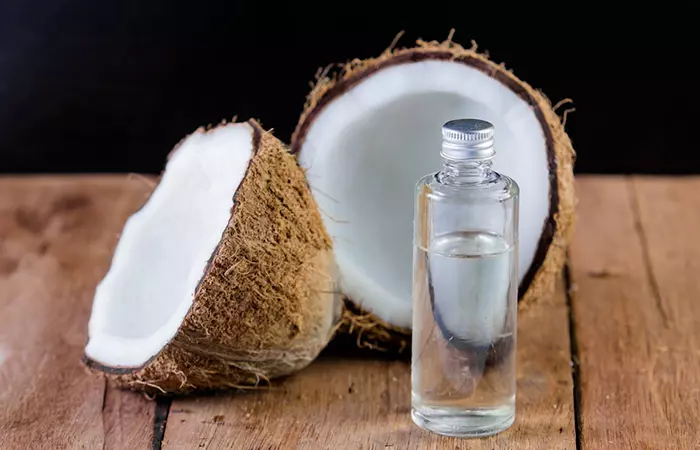
You Will Need
Coconut oil (as required)
What You Have To Do
- Massage a little coconut oil gently into your baby’s scalp.
- Leave it on for 20 minutes before washing it off.
How Often You Should Do This
Do this once daily.
Why This Works
Coconut oil is widely used for its moisturizing, anti-inflammatory, and antifungal properties
(1), (2). It is a good moisturizer that helps soften the scaly scalp, reduce inflammation, and fight microbial infections (if any).
A blogger used a coconut oil remedy for her toddler and achieved promising results. She applied coconut oil and scrubbed the scalp and then washed it with a mild shampoo. She said, “It seems to have worked! After her bath tonight, it looked very promising (i).”
2. Baking Soda
You Will Need
- 1 teaspoon of baking soda
- 2 teaspoons of water
What You Have To Do
- Mix a teaspoon of baking soda with some water to form a paste.
- Apply this paste to your baby’s scalp and leave it on
- for a minute or two.
- Wash it off.
How Often You Should Do This
You must do this once daily, preferably before bathing your baby.
Why This Works
The anti-inflammatory and neutralizing properties of baking soda help restore the natural pH of your baby’s scalp (3). This, in turn, helps reduce the flakiness. Baking soda also has antibacterial properties that eliminate any microbes present in the scalp (4).
3. Breast Milk
You Will Need
A few drops of breast milk
What You Have To Do
- Take a few drops of breast milk and gently apply it to your baby’s scalp.
- Leave it on for a few minutes before washing it off with water.
How Often You Should Do This
You must do this once daily.
Why This Works
Breast milk is a rich source of various antibodiesi A type of protein produced by the immune system in order to prevent unwanted substances from entering the body. that boost your baby’s immunity (5). Its topical application softens the dry and scaly scalp, thereby making the removal of the flakes easier (6).
4. Essential Oils
a. Tea Tree Oil
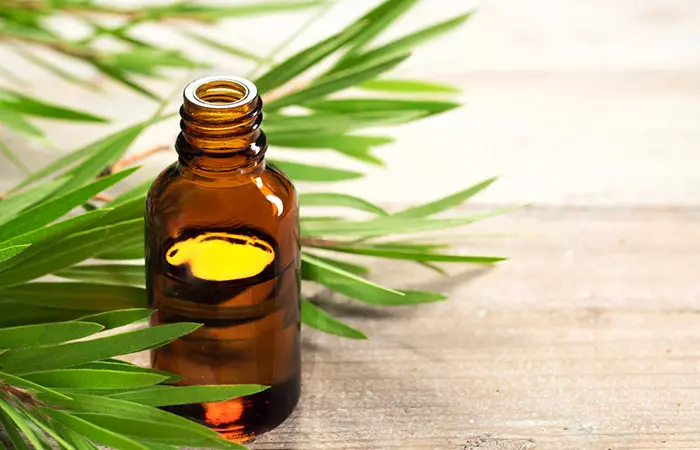
You Will Need
- 2 drops of tea tree oil
- 2 tablespoons of coconut oil
What You Have To Do
- Add two drops of tea tree oil to two tablespoons of coconut oil and mix well.
- Apply this mixture directly to the scalp.
- Leave it on for 15 to 20 minutes.
- Wash it off.
How Often You Should Do This
Do this once daily.
Why This Works
Tea tree oil is widely used for treating various skin ailments due to its anti-inflammatory and antimicrobial properties (7). The antifungal properties of tea tree oil eliminate the Malassezia species of fungi, which is one of the causes of cradle cap (8).
b. Lavender Oil
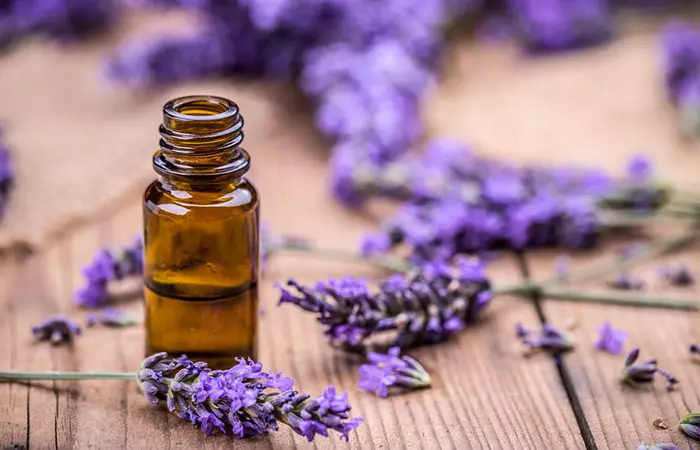
You Will Need
- 2 drops of lavender oil
- 2 tablespoons of coconut oil
What You Have To Do
- Mix two drops of lavender oil with two drops of coconut oil.
- Apply the mixture to your infant’s scalp.
- Leave it on for 15 to 20 minutes and then bathe your baby.
How Often You Should Do This
Do this daily.
Why This Works
The antifungal properties of lavender oil fight the fungi that are responsible for the formation of cradle cap (9). It can also help in softening the scales and make their removal easier.
5. Vaseline
You Will Need
Vaseline (as required)
What You Have To Do
- Apply some Vaseline to your baby’s scalp.
- Leave it on for an hour or two, after which you can brush your baby’s scalp gently.
How Often You Should Do This
Do this daily for a week.
Why This Works
Vaseline has amazing moisturizing properties that can soften the dry and scaly scalp of your little one. According to anecdotal evidence, the softened flakes fall off easily, and the cradle cap will vanish in a week.
6. Lemon Juice
You Will Need
- 1 teaspoon of lemon juice
- 2 teaspoons of coconut oil
What You Have To Do
- Mix a teaspoon of lemon juice with two teaspoons of coconut oil.
- Apply this mixture to your infant’s scalp.
- You can also scrub lightly with a lemon peel to dislodge the flakes.
- Leave it on for 15 to 20 minutes and then wash it off.
How Often You Should Do This
Do this once daily or every alternate day.
Why This Works
Lemon has anti-inflammatory, antimicrobial, and bactericidal properties that can help in combating seborrheic dermatitisi A condition occurring in babies as well as grownups in which scaly patches and red skin appear on the scalp and other oily parts of the body. -causing yeast and bacteria on the scalp (10), (11). If left untreated it may also cause seborrheic dermatitis hair loss in adults as well.
7. Almond Oil
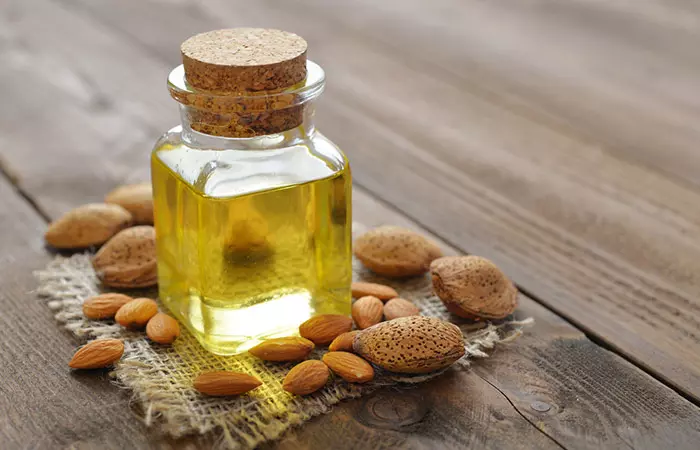
You Will Need
Almond oil
(as required)
What You Have To Do
- Apply a little almond oil to your scalp and massage gently.
- Leave it on for 15 to 20 minutes.
- Using a soft brush, gently comb your baby’s scalp.
- Once the oily flakes come off, you can bathe your baby.
How Often You Should Do This
You must do this at least once daily.
Why This Works
Almond oil is quickly absorbed by the skin. It can help dislodge the debris and flakes from the hair follicles, thus helping you get rid of cradle cap. It also has anti-inflammatory properties and can help soothe any inflammation in your baby’s scalp(12).
8. Apple Cider Vinegar
You Will Need
- 1 tablespoon of apple cider vinegar
- 2 tablespoons of water
What You Have To Do
- Mix a tablespoon of apple cider vinegar with two tablespoons of water.
- Apply this mixture to your baby’s scalp.
- Leave it on for 10 to 15 minutes and then wash it off with water.
How Often You Should Do This
You must do this twice a week for 2 to 3 weeks.
Why This Works
The acidic nature of apple cider vinegar plays an important role in getting rid of cradle cap. According to anecdotal evidence, ACV restores the lost pH of your baby’s scalp, which may speed up healing. Its anti-inflammatory and antifungal properties reduce inflammation and fight the microbes responsible for causing cradle cap (13).
9. Aloe Vera
You Will Need
1/2 tablespoon of aloe vera gel
What You Have To Do
- Take some aloe vera gel and apply it directly to your baby’s scalp.
- Leave it on.
How Often You Should Do This
You must do this daily, preferably after bathing your little one.
Why This Works
Aloe vera gel is used for treating a variety of skin conditions, including cradle cap. The soothing and moisturizing properties of aloe vera may help speed up the recovery of this scalp problem (14). The antifungal properties of this gel offer protection from the potential threats like Malassezia species of fungi (15).
10. Argan Oil
You Will Need
5-6 drops of argan oil
What You Have To Do
- Take a few drops of argan oil and massage it gently into your baby’s scalp.
- Leave it on for 30 minutes to 1 hour.
- Bathe your baby.
How Often You Should Do This
You can do this once daily.
Why This Works
Argan oil is a rich source of vitamin E, which is known to heal many skin conditions. The healing and anti-inflammatory properties of argan oil help in treating cradle cap (16).
11. Castor Oil
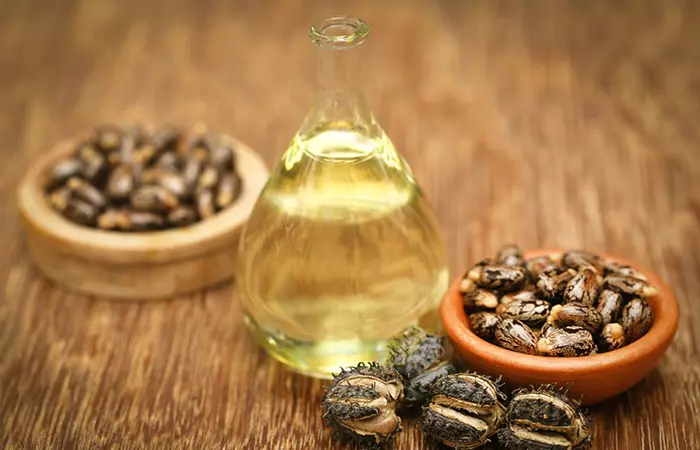
You Will Need
A few drops of castor oil
What You Have To Do
- Apply a few drops of castor oil to your infant’s scalp.
- Massage gently and leave it on for an hour.
- Bathe your baby and remove the dislodged flakes from his/her scalp using a soft brush.
How Often You Should Do This
You must do this on a daily basis.
Why This Works
Castor oil helps to seal in the moisture of your infant’s scalp (17). This can keep it well-moisturized and help in getting rid of cradle cap permanently.
12. Olive Oil
You Will Need
Olive oil (as required)
What You Have To Do
- Apply some olive oil to your infant’s scalp.
- Leave it on for an hour and then wash it off.
- Using a soft brush, remove the dislodged flakes from your little one’s scalp.
How Often You Should Do This
Do this on a daily basis until you notice an improvement in your baby’s condition.
Why This Works
Olive oil is another popular remedy for getting rid of cradle cap. It is quite moisturizing and can help in softening and dislodging the thick flakes and crusts on the scalp. And its antifungal properties protect the scalp from fungal infections (18).
13. Jojoba Oil
You Will Need
Jojoba oil (as required)
What You Have To Do
- Apply a small amount of jojoba oil to the affected area on your baby’s scalp.
- Gently massage the oil into the scalp.
- Leave it on for about an hour to allow the oil to soften the flakes and crusts on the scalp.
- Use a soft brush or a fine-toothed comb to gently remove the flakes.
How Often You Should Do This
You can do this daily.
Why This Works
Cradle cap is a type of seborrheic dermatitis that affects only infants. And, jojoba oil is a gentle and effective remedy for treating seborrheic dermatitis (19). Its natural moisturizing properties help soften and loosen the thick scales on the scalp. It may also provide a protective barrier to prevent further dryness and flaking.
 Quick Tip
Quick TipFollowing these remedies is not always enough. Your little one might still be at the risk of developing cradle cap again. Hence, you must consider following a few tips to prevent the recurrence of this condition. They are as discussed below.
How To Prevent Cradle Cap
- Wash your baby’s head on a daily basis and use baby shampoo twice a week.
- Use your fingers or a brush with soft bristles to rub on your baby’s scalp gently. This can improve blood circulation in the scalp.
- Try to increase your biotini A type of vitamin B that participates in various metabolic processes and helps keep the skin, liver, hair, and eyes healthy. intake by consuming foods like eggs, almonds, cauliflower, spinach, cheese, and mushrooms.
Follow these preventive measures to prevent cradle cap and minimize its impact. However, if the condition persists or worsens, you should seek professional advice immediately. Learn more below.
When To Seek Help
If your baby’s cradle cap persists despite trying these home remedies, worsens, or is accompanied by additional symptoms like fever, excessive redness, or irritability, consult a pediatrician or dermatologist.
These healthcare professionals can accurately diagnose the cause of the condition and recommend appropriate medical treatments, such as medicated shampoos or ointments. Early intervention can help alleviate discomfort and prevent complications.
Infographic: The Dos & Don’ts Of Cradle Cap
Cradle cap is a common, harmless skin condition seen in babies. Though it goes away on its own, there are several home remedies that can help treat cradle cap. While these remedies are effective, you should also be aware of the certain dos and don’ts while treating this condition.
Check out the infographic below to learn how to be careful if your child has a cradle cap. Illustration: StyleCraze Design Team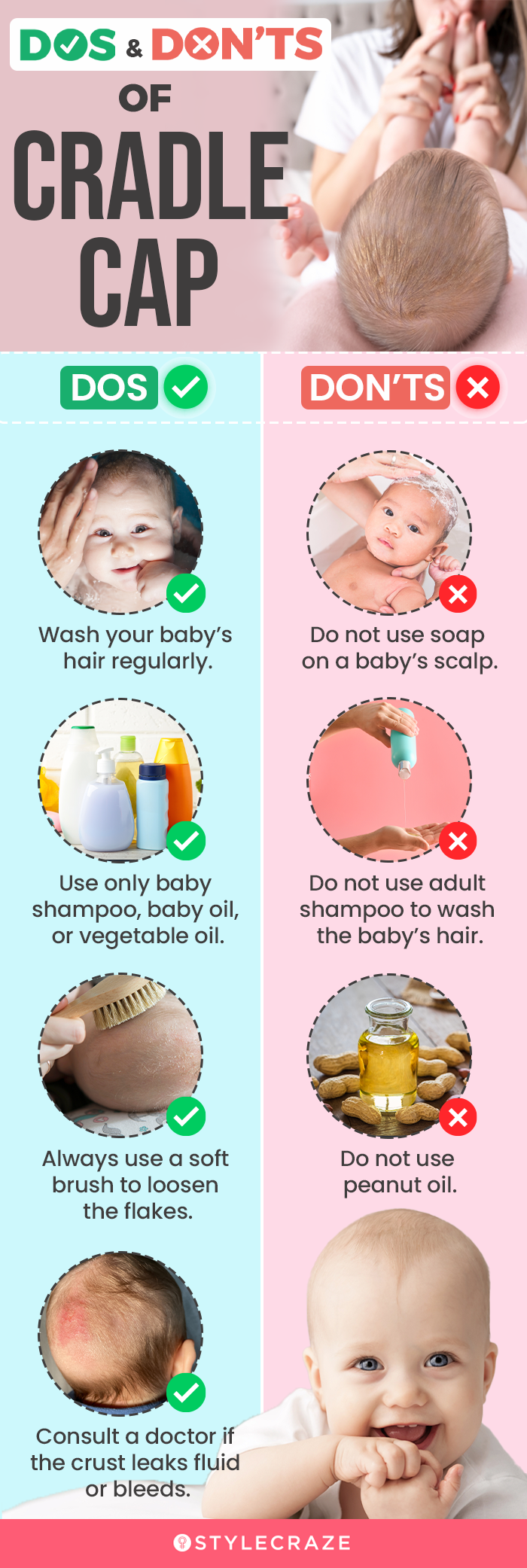
 Quick Tip
Quick TipA cradle cap is a fungal infection commonly seen in infants. Though it subsides naturally with gentle cleansing, some remedies and maintaining proper hygiene can help accelerate the healing process. Using coconut oil, olive oil, argan oil, castor oil, almond oil, and essential oils effectively manages the cradle cap. Baking soda, breast milk, oatmeal, chamomile, calendula oil, shea butter, lemon juice, vaseline, apple cider vinegar, and aloe vera also help with cradle cap treatment. In addition to these, washing the baby’s head daily and gently using a soft bristle brush to rub baby hair helps prevent cradle cap. If the condition persists, it is advised to consult a dermatologist for treatment.
Frequently Asked Questions
Does cradle cap affect hair growth?
Although cradle cap does not directly affect hair growth, it could cause hair loss while combing and trying to get it off your baby’s scalp.
How long does it take for cradle cap to go away?
Cradle cap usually disappears on its own before an infant completes 12 months. But in some cases, it is observed in children aged above 1 year as well.
Can a 2-year-old still have a cradle cap?
A cradle cap usually clears up by the baby’s first birthday. However, in some cases, it might last till they turn 2 to 4 years old.
Is it OK to pick the cradle cap off?
No, do not pick or scratch the cradle cap off as it may further aggravate the condition and even cause bacterial co-infection (20).
Is cradle cap a form of eczema?
No, there is no link between cradle cap and eczem. While eczema may also occur at the same place as a cradle cap, the two are different conditions.
Is cradle cap a symptom of milk allergy?
Some believe a cradle cap can be a symptom of milk allergy. In some infants, this allergy manifests also as rashes, hives, swollen eyelids and lips, and flushed cheeks. However, limited research is available in this regard.
Illustration: How To Get Rid Of Cradle Cap In Toddlers & Tips To Prevent It
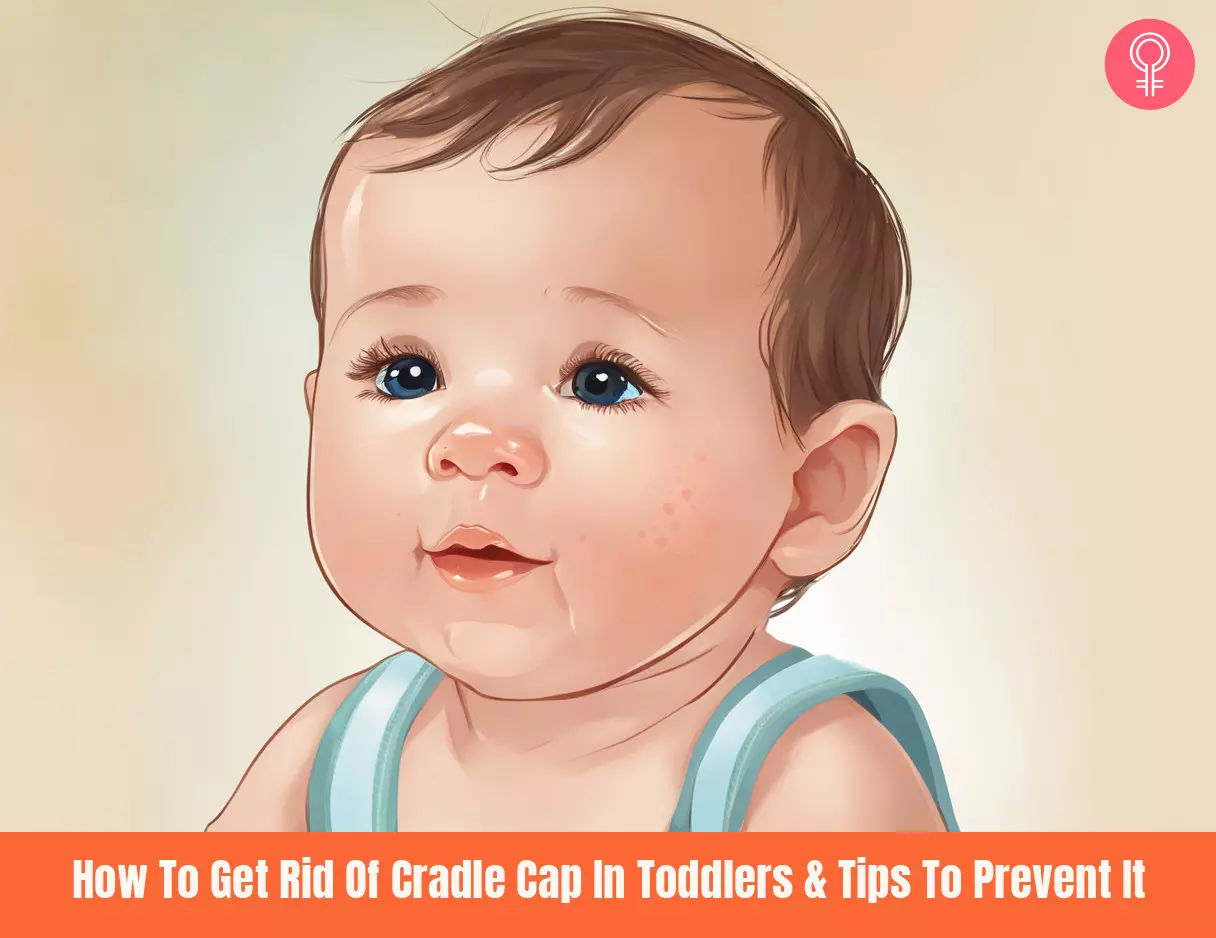
Image: Stable Diffusion/StyleCraze Design Team
Cradle cap can be concerning but treating it might be easier than you think! Watch this video to get the best advice on how to keep your baby’s scalp healthy and free of flakes. Check it out now!
Personal Experience: Source
StyleCraze's articles are interwoven with authentic personal narratives that provide depth and resonance to our content. Below are the sources of the personal accounts referenced in this article.
i. Cradle Caphttps://curlyqshairdos.blogspot.com/2010/01/cradle-cap.html
References
Articles on StyleCraze are backed by verified information from peer-reviewed and academic research papers, reputed organizations, research institutions, and medical associations to ensure accuracy and relevance. Read our editorial policy to learn more.
- Enhanced barrier functions and anti-inflammatory effect of cultured coconut extract on human skin
https://pubmed.ncbi.nlm.nih.gov/28564614/ - In vitro antimicrobial properties of coconut oil on Candida species in Ibadan, Nigeria
https://pubmed.ncbi.nlm.nih.gov/17651080/ - Drinking baking soda could be an inexpensive, safe way to combat autoimmune disease
https://www.sciencedaily.com/releases/2018/04/180425093745.htm - Antibacterial activity of baking soda
https://pubmed.ncbi.nlm.nih.gov/12017929/ - Human milk: Defense against infection
https://pubmed.ncbi.nlm.nih.gov/6798576/ - Efficacy of topical application of human breast milk on atopic eczema healing among infants: a randomized clinical trial
https://pubmed.ncbi.nlm.nih.gov/25640116/ - Anti-inflammatory effects of Melaleuca alternifolia essential oil on human polymorphonuclear neutrophils and monocytes
https://pubmed.ncbi.nlm.nih.gov/15493453/ - Role of antifungal agents in the treatment of seborrheic dermatitis
https://pubmed.ncbi.nlm.nih.gov/15663338/ - Antifungal Effect of Lavender Essential Oil (Lavandula angustifolia) and Clotrimazole on Candida albicans: An In Vitro Study
https://www.ncbi.nlm.nih.gov/pmc/articles/PMC4621348/ - Phytochemical, antimicrobial, and antioxidant activities of different citrus juice concentrates
https://www.ncbi.nlm.nih.gov/pmc/articles/PMC4708628/ - Bactericidal activity of lemon juice and lemon derivatives against Vibrio cholerae
https://pubmed.ncbi.nlm.nih.gov/11041258/ - The uses and properties of almond oil
https://pubmed.ncbi.nlm.nih.gov/20129403/ - Antifungal and Antibacterial Activities of Apple Vinegar of Different Cultivars
https://www.ncbi.nlm.nih.gov/pmc/articles/PMC8369171/ - Antifungal activity of Aloe vera leaves
https://pubmed.ncbi.nlm.nih.gov/17336466/ - ALOE VERA: A SHORT REVIEW
https://www.ncbi.nlm.nih.gov/pmc/articles/PMC2763764/ - Benefits of Argan Oil on Human Health—May 4–6 2017, Errachidia, Morocco
https://www.ncbi.nlm.nih.gov/pmc/articles/PMC5535876/ - Castor Oil: Properties, Uses, and Optimization of Processing Parameters in Commercial Production
https://www.ncbi.nlm.nih.gov/pmc/articles/PMC5015816/ - Antifungal Activity of Cinnamon Oil and Olive Oil against Candida Spp. Isolated from Blood Stream Infections
https://www.ncbi.nlm.nih.gov/pmc/articles/PMC5028442/ - Anti-Inflammatory and Skin Barrier Repair Effects of Topical Application of Some Plant Oils
https://www.ncbi.nlm.nih.gov/pmc/articles/PMC5796020/ - Cradle Cap
https://www.ncbi.nlm.nih.gov/books/NBK531463/
Read full bio of Dr. Zeel Gandhi
Read full bio of Shaheen Naser
Read full bio of Anjali Sayee
Read full bio of Swathi E






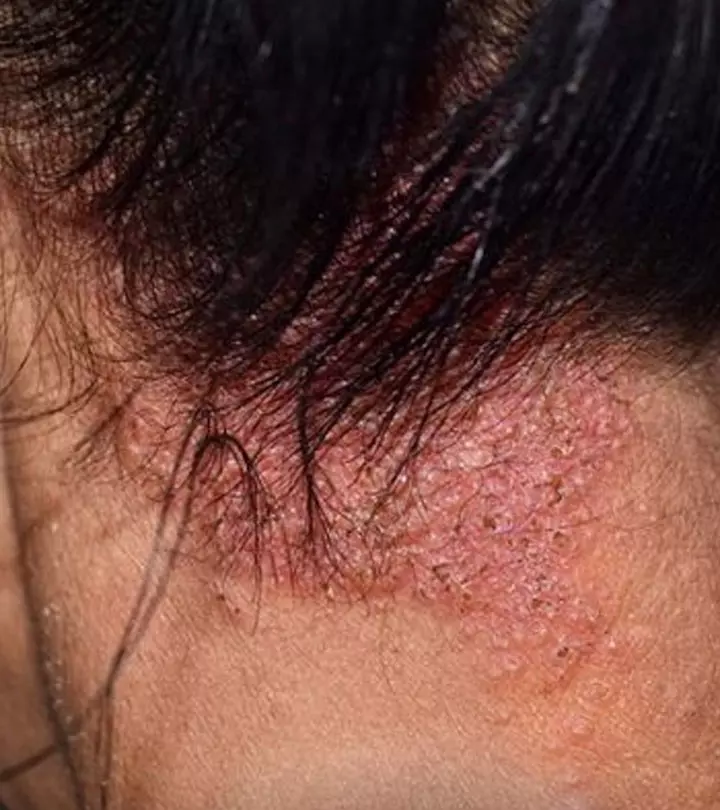
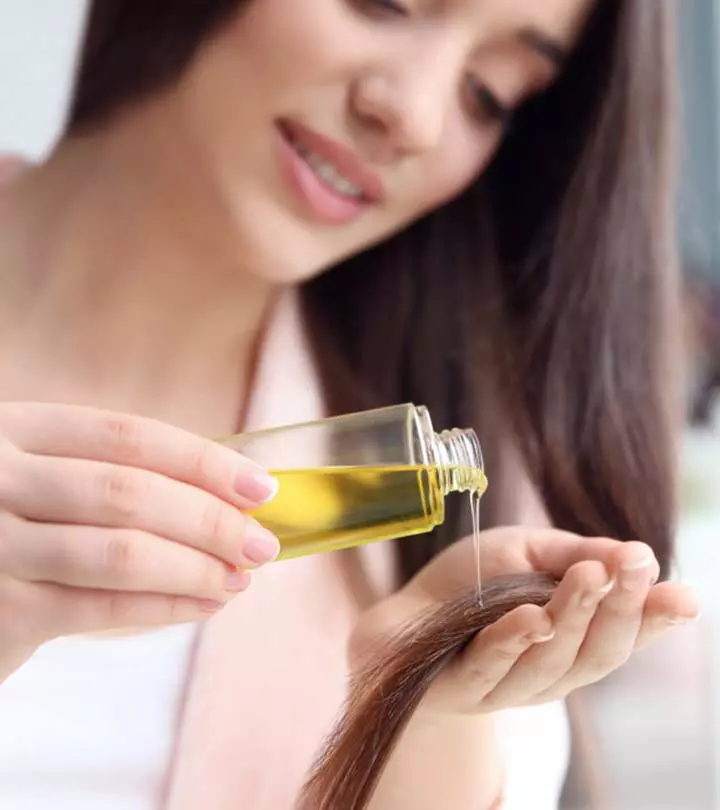
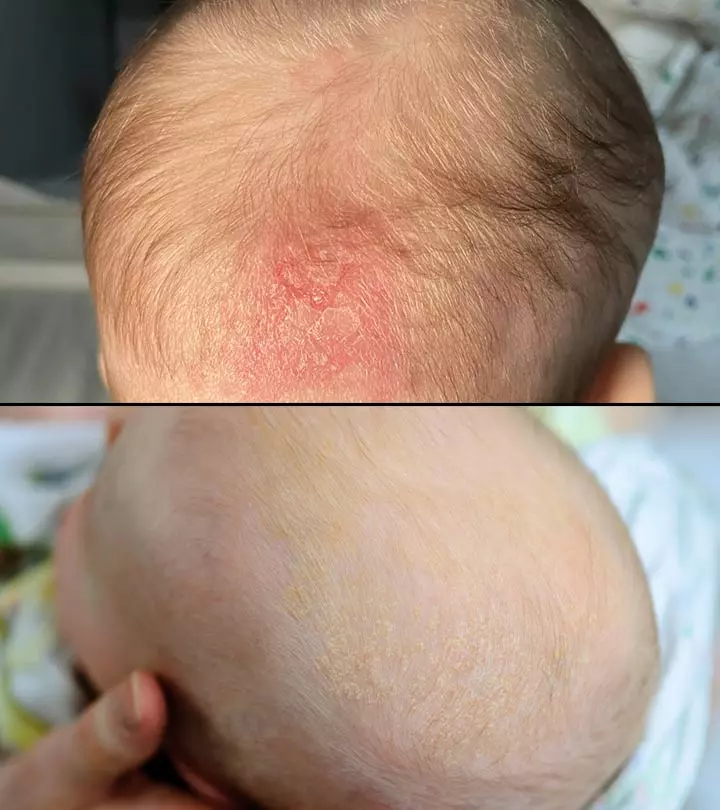

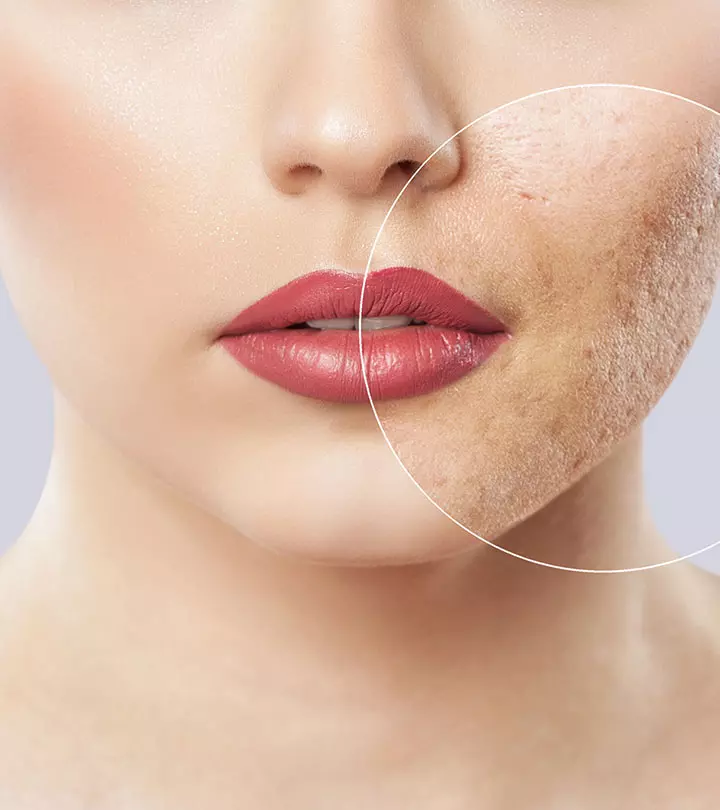
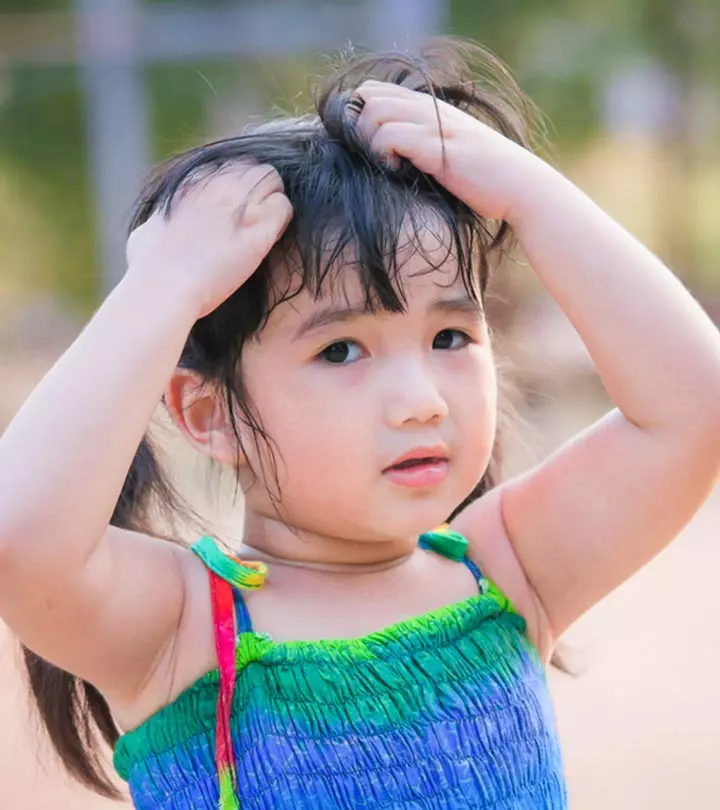

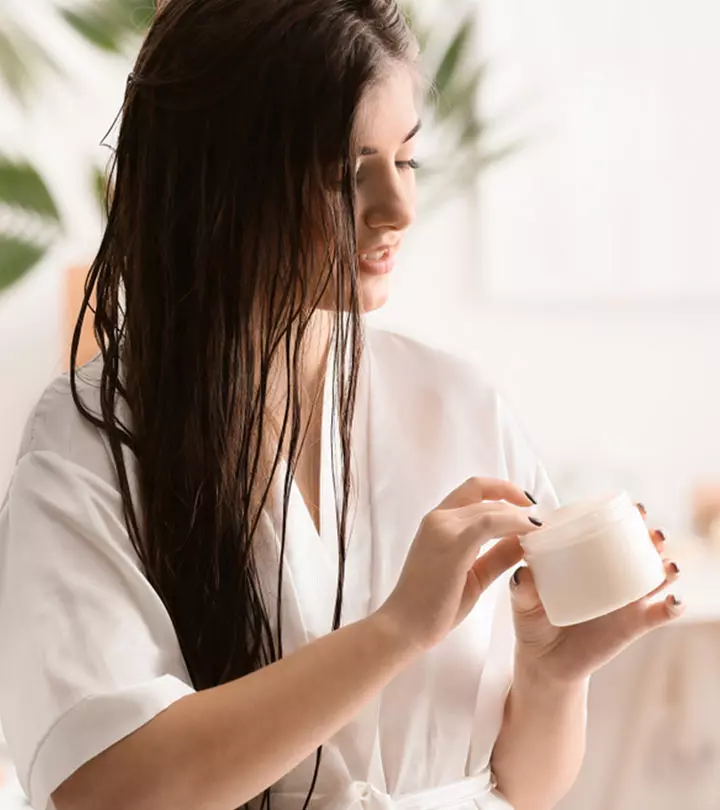
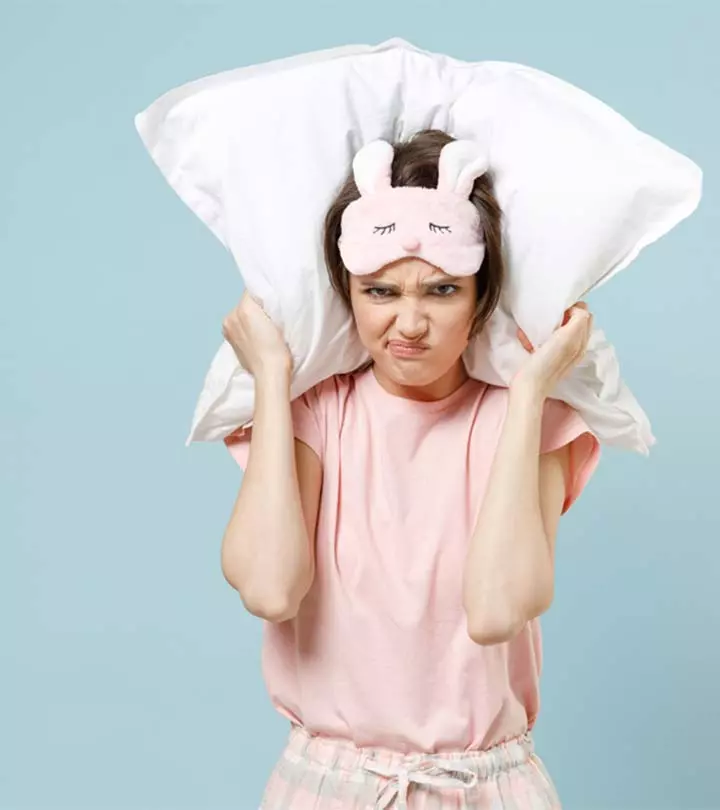
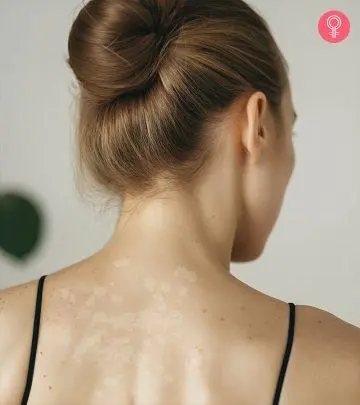


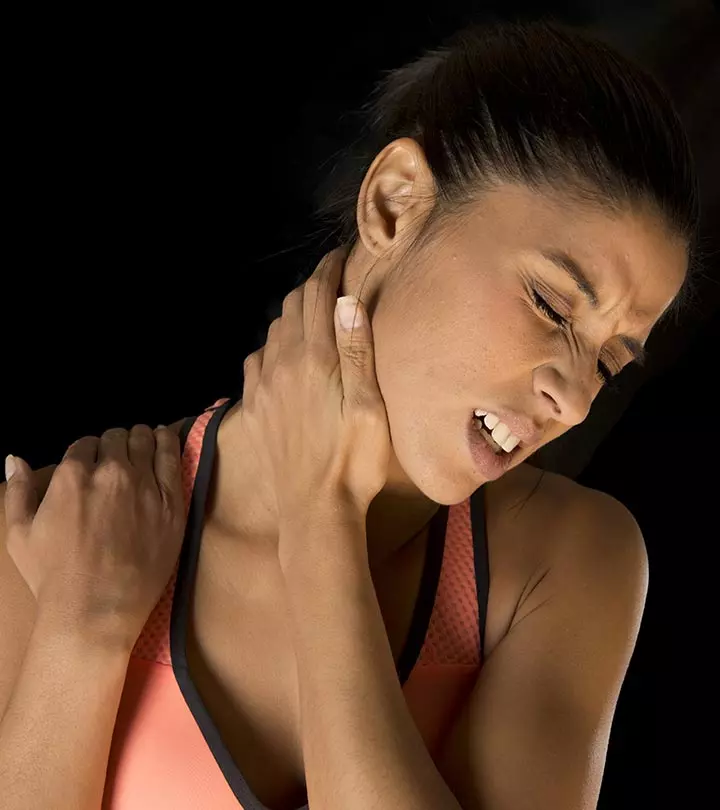


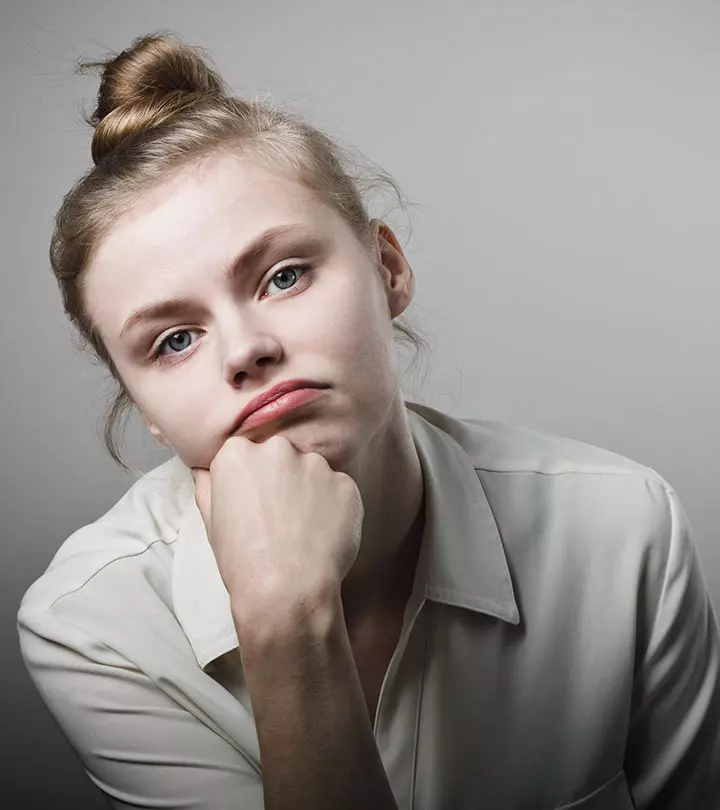




Community Experiences
Join the conversation and become a part of our empowering community! Share your stories, experiences, and insights to connect with other beauty, lifestyle, and health enthusiasts.